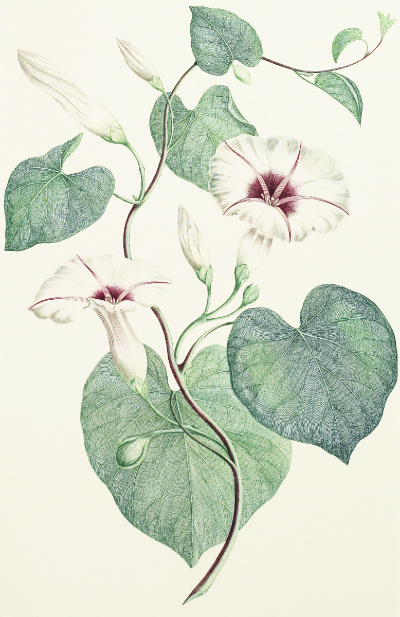
SYDNEY PARKINSON (artist)
‘Plate 631. Ipomoea Illustris (Clarke) Prain, Convolvulus grandiflorus [alpha] (Convolvulaceae)’
London: Alecto Historical Editions in association with the British Museum (Natural History), 1980-1990
Engraving by Charles White, printed à la poupée by Alecto Historical Editions
Limited to 116 impressions, this no. 83 of 100 and numbered 83/100
❧ IPOMOEA ILLUSTRIS (CLARKE) PRAIN, CONVOLVULUS GRANDIFLORUS (CONVULACEAE)
Species seen at Tahiti, Society Islands
13 April – 1 June / 4 June and 13 July 1769
The approach to Tahiti, after the stop at Tierra del Fuego in January 1769, had taken roughly five months, during which Banks and Solander perfected the art of sketching plants amidst the gales and rain on sea. ‘Their procedure here and later was to put the living specimens in chests and cover them with damp cloth to keep them fresh for study during the next few days’ (Stearn, ‘A Royal Society Appointment’, p. 103).
Once they arrived at the Society Islands (named thus because they form a group of closely related islands), of which they visited five, Banks and Solander had a wealth of previously unknown plants to explore. Parkinson prepared 14 sketches and 114 coloured drawings of the plants they gathered in these three months. Interestingly, Parkinson’s artistic skill was appreciated by the indigenous peoples, as he recalls: ‘I shewed him [i.e. a middle-aged local man named Lycurgus] some of my drawings, which he greatly admired, and pronounced their names as soon as he saw them’ (Parkinson, A Journal of a Voyage, p. 18).
The Ipomea Illustris, which is widespread among the Pacific Islands and belongs to the morning glory family, was among the new species Banks and his team discovered. Sydney Parkinson describes two uses of convolvulus leaves in his journal’s account of Tahiti: ‘boys drag for fish with a sort of net made of convolvulus leaves; and sometimes catch them with hooks made of mother of pearl oysters, large-pinna marina, and other shells; and the shapes of them are very singular’. They were also used in ‘a peculiar method of staining . . . garments: a girl that was present shewed me the whole process, which is as follows: — She took the young leaves of a convolvulus unfoliated, and then broke off the tops of a small fig, of a reddish hue, and squeezed out of it a milky fluid, which she spread on a leaf, rubbing it gently to mix it with the juice of the leaf, and then it became red; this she soaked up with the leaf of a solanum, and then daubed it upon some cloth’ (Parkinson, A Journal of a Voyage, pp. 19 and 18).
SPECIFICATIONS
The engravings are all of a very similar size, with platemarks of circa 457 x 305mm, and are printed on acid-free Somerset mould-made 300gsm paper manufactured by the Inveresk Paper Company. Each sheet is watermarked ‘AHE’, measures 724 x 556mm, and bears blind embossed stamps incorporating the publishers’ and printer’s chops, the copyright symbol, and date of publication; the initials of the individual printer, the plate number, and the edition number are recorded in pencil. The engravings are protected by a bifolium of acid-free Somerset mould-made 300gsm paper, cut to form a window mount on which is recorded the modern and Banksian names of the plant, the location and date of its collection and the name(s) of the artist and engraver.
This print accompanied by a certificate of limitation.
This print is no longer available.
© Type & Forme and Alecto Historical Editions/Trustees of the Natural History Museum 2020

